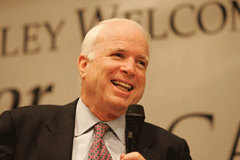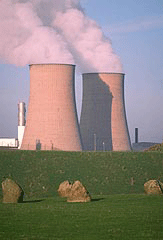Nuclear Power Politics
Air Date: Week of October 10, 2008

Senator John McCain. (Courtesy of U.S. House of Representatives)
The presidential candidates are going head-to-head on nuclear power. But the nuclear industry says Senators Barack Obama and John McCain aren't that far apart when it comes to a commitment to build more nuclear reactors. This week, Living on EarthÂ’s Jeff Young reports on John McCainÂ’s views on nuclear power.
Transcript
GELLERMAN: From the Jennifer and Ted Stanley studios in Somerville, Massachusetts, This is Living on Earth. IÂ’m Bruce Gellerman, in for Steve Curwood.
While the economic crisis is dominating the presidential campaign, energy and environmental issues are still getting significant play in the presidential debates. In their second debate in Nashville, Senators John McCain and Barack Obama went head-to-head on climate change.
MCCAIN: What's the best way of fixing it? Nuclear power. Senator Obama says that it has to be safe or disposable or something like that. Look, I've – I was on Navy ships that had nuclear power plants. Nuclear power is safe, and it's clean, and it creates hundreds of thousands of jobs.
OBAMA: And I've called for investments in solar, wind, geothermal. Contrary to what Senator McCain keeps on saying, I favor nuclear power as one component of our overall energy mix. But this is another example where I think it is important to look at the record.
GELLERMAN: Which is precisely what Living on EarthÂ’s Jeff Young is going to do. With a close look at where the presidential candidates stand on nuclear power. This week: John McCain.
YOUNG: After almost 30 years of near zero growth in the U.S., nuclear industry leaders say they are poised for a nuclear renaissance. And Senator John McCain is a nuclear renaissance man.
MCCAIN: IÂ’d like to say, IÂ’m very grateful to be here at the Fermi Nuclear Plant. I want to thank the great workers and people here who have made nuclear power safe, efficient, inexpensive and obviouslyÂ…
YOUNG: In August McCain toured the Enrico Fermi Nuclear Generating site in Michigan—a venue that struck some as an odd place to highlight nuclear safety. Nuclear opponent Jim Riccio of Greenpeace:
RICCIO: It’s one of the few sites in the U.S. where you’ve actually already had a meltdown. It was an experimental breeder reactor, and that reactor experienced a partial core melt back in ‘66. So it was ironic that of all the places in the U.S. that the senator could go he chose the site of a meltdown.

Cooling towers at a nuclear power plant (Courtesy of the Department of Energy)
FLINT: No, the Fermi plant operates very safely.
YOUNG: ThatÂ’s Alex Flint, the Nuclear InstituteÂ’s senior vice president for
government affairs.
FLINT: The entire nuclear renaissance is based on the fact that the 104 plants operating today have an extraordinary safety and environmental record. And it is that, itÂ’s the safety and environmental record of the existing plants that makes it possible for us to contemplate this renaissance in nuclear power.
YOUNG: But what happened at Fermi in 1966?
FLINT: Uh that was three years before I was born, IÂ’ll have to go off and ask somebody.
YOUNG: I think they had meltdown.
FLINT: No. no.
YOUNG: Flint called a colleague who confirmed FermiÂ’s meltdown history.
FLINT: (on phone) Okay, thatÂ’s what I needed. Thanks. (Hangs up) Well, you asked me a question I never heard before.
YOUNG: It was an awkward moment. And it reflects a larger awkward phase for the nuclear industry. The presidential campaign puts it in the limelight as a potential energy source for the future. But that also brings into focus nagging problems from the past—questions about safety, waste, and tremendous cost. McCain believes those challenges pale compared to the threat of global warming.
MCCAIN: And, you can't be serious, you can't be serious about reducing the effect of greenhouse gas emissions unless you factor in nuclear power into the equation.
YOUNG: That was McCain in an interview with Living on Earth in 2004. The following year he added incentives for nuclear power to his Climate Stewardship Act, which aimed to cut greenhouse gas emissions. That alienated some environmental allies and cost crucial votes in the Senate, where the Act failed.

Senator John McCain. (Courtesy of U.S. House of Representatives)
Now McCain proposes 45 new reactors by the year 2030—and a longer-term goal of 100 reactors. Again, environmentalists like Jim Riccio, who applauded McCain for tackling global warming, are aghast at his insistence on nuclear power.
RICCIO: If you actually want to address climate change you need to do things that are fast and affordable. Last year we put 5,000 megawatts of wind on the grid here in the United States. YouÂ’re not going to put that kind of nuclear power on the grid for well over a decade and by then climate change will be upon us, and potentially unabateable.
YOUNG: The Nuclear Institute says 45 reactors would keep nuclear at 20 percent of the countryÂ’s electricity mix as demand rises. But some who watch energy investments arenÂ’t so sure the money to build them would be there. Kevin Book is an energy analyst with FBR, an investment bank in Arlington, Virginia.
BOOK: It will be a stretch, to be quite frank. The problem will be getting them built, and getting them built with the labor force we have, and at prices that local regulated utilities will want to pay. YouÂ’re still going to need a lot of money and youÂ’re going to need a lot of time. ItÂ’s 2008, last time I checked. That gives 22 years to build 45 of something we havenÂ’t built in 30 years. From my perspective that sounds like a challenge.
YOUNG: Book says pinning down the cost is tricky—estimates for a new reactor vary from four to nearly 11 billion dollars. At, say, seven billion each, McCain’s proposal means 315 billion dollars someone has to come up with. And that someone could be you, as a ratepayer or taxpayer. The industry would get billions in production tax credits. And taxpayers could be on the hook for much greater sums if companies default on government-guaranteed loans. And then there is the question of what to do with the waste. McCain wants to finish the Yucca Mountain repository for permanent underground storage. But that project faces opposition in congress and the courts. McCain also wants the U.S. to reprocess the spent fuel.
MCCAIN: The Japanese, the British, the French do it, and we can do it too.
YOUNG: Reprocessing—sometimes called recycling—separates useful material from spent fuel. But it’s controversial among nuclear experts. MIT professor and former Clinton administration energy department official Ernie Moniz says it’s a bad idea.
MONIZ: There is a misconception that the program in France, for example, that relies upon plutonium recycling, has somehow solved the waste management problem. It has not. It costs more, it creates stores of plutonium. So there are some issues there that need to be clarified.
YOUNG: So both of McCainÂ’s plans for dealing with waste would run into opposition. Financing construction of new reactors would be very tough. And safety concerns from environmentalists would complicate McCainÂ’s effort to link nuclear power incentives to climate change legislation. But for all the criticism McCain catches, he has at least been consistent. Which has not been the case with his opponent.
OBAMA: I am not a nuclear energy proponent.
YOUNG: This was Senator Obama last year. HereÂ’s Obama this month.
OBAMA: I favor nuclear power as one component of our overall energy mix.
YOUNG: Just where does the Democratic presidential candidate stand? WeÂ’ll take a look at his nuclear record next week.
For Living on Earth, IÂ’m Jeff Young in Washington.
Links
Nuclear Energy Institute on outlook for new reactors
Living on Earth wants to hear from you!
Living on Earth
62 Calef Highway, Suite 212
Lee, NH 03861
Telephone: 617-287-4121
E-mail: comments@loe.org
Newsletter [Click here]
Donate to Living on Earth!
Living on Earth is an independent media program and relies entirely on contributions from listeners and institutions supporting public service. Please donate now to preserve an independent environmental voice.
NewsletterLiving on Earth offers a weekly delivery of the show's rundown to your mailbox. Sign up for our newsletter today!
 Sailors For The Sea: Be the change you want to sea.
Sailors For The Sea: Be the change you want to sea.
 The Grantham Foundation for the Protection of the Environment: Committed to protecting and improving the health of the global environment.
The Grantham Foundation for the Protection of the Environment: Committed to protecting and improving the health of the global environment.
 Contribute to Living on Earth and receive, as our gift to you, an archival print of one of Mark Seth Lender's extraordinary wildlife photographs. Follow the link to see Mark's current collection of photographs.
Contribute to Living on Earth and receive, as our gift to you, an archival print of one of Mark Seth Lender's extraordinary wildlife photographs. Follow the link to see Mark's current collection of photographs.
 Buy a signed copy of Mark Seth Lender's book Smeagull the Seagull & support Living on Earth
Buy a signed copy of Mark Seth Lender's book Smeagull the Seagull & support Living on Earth

